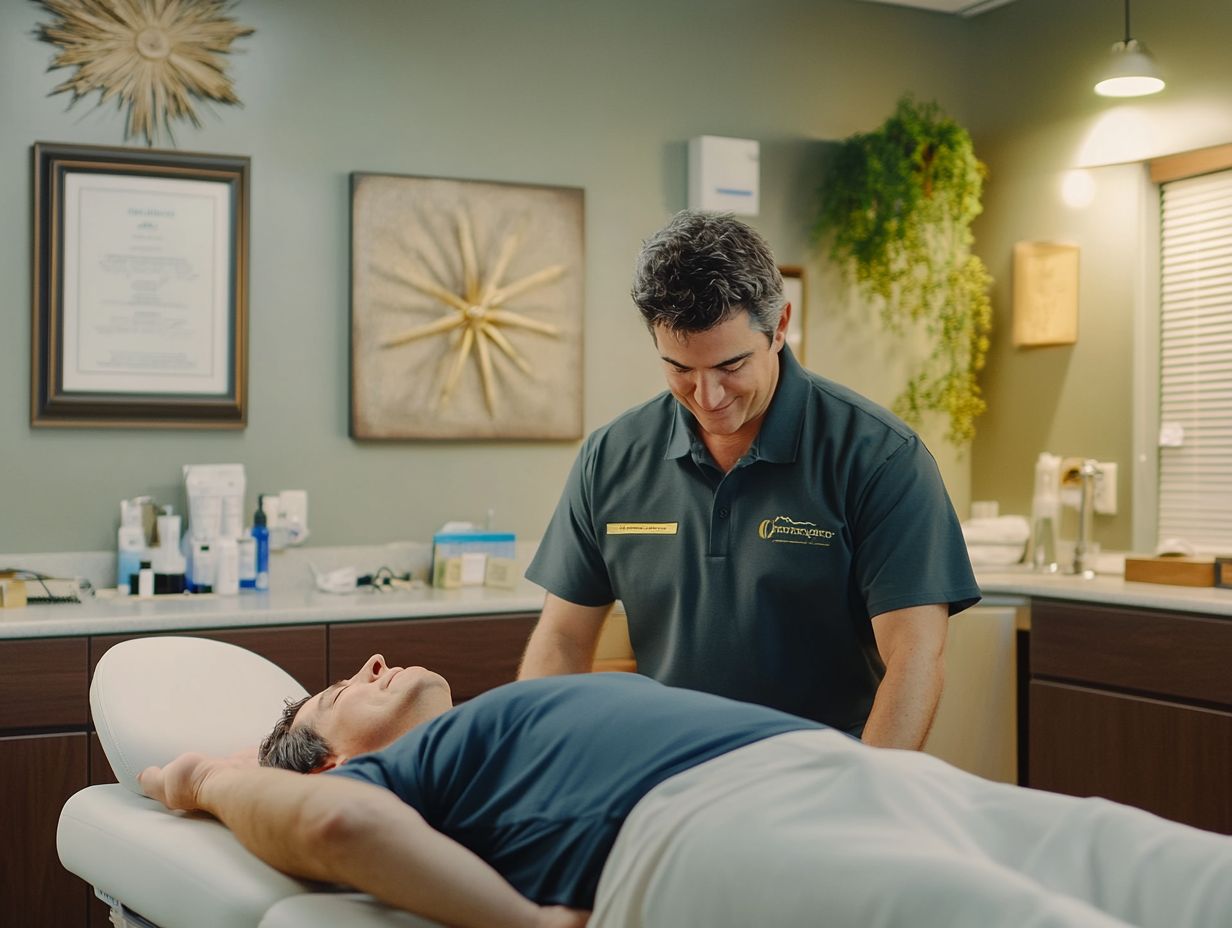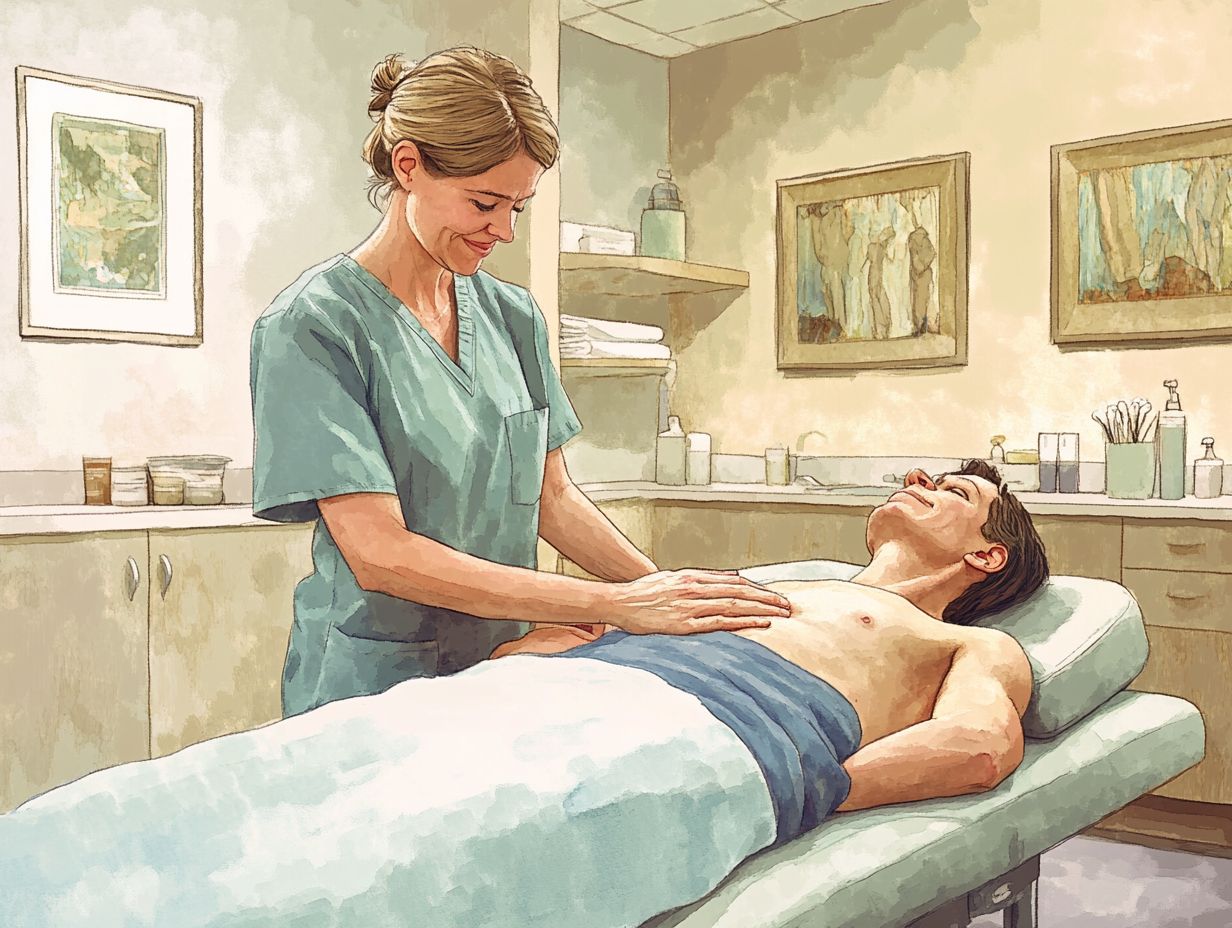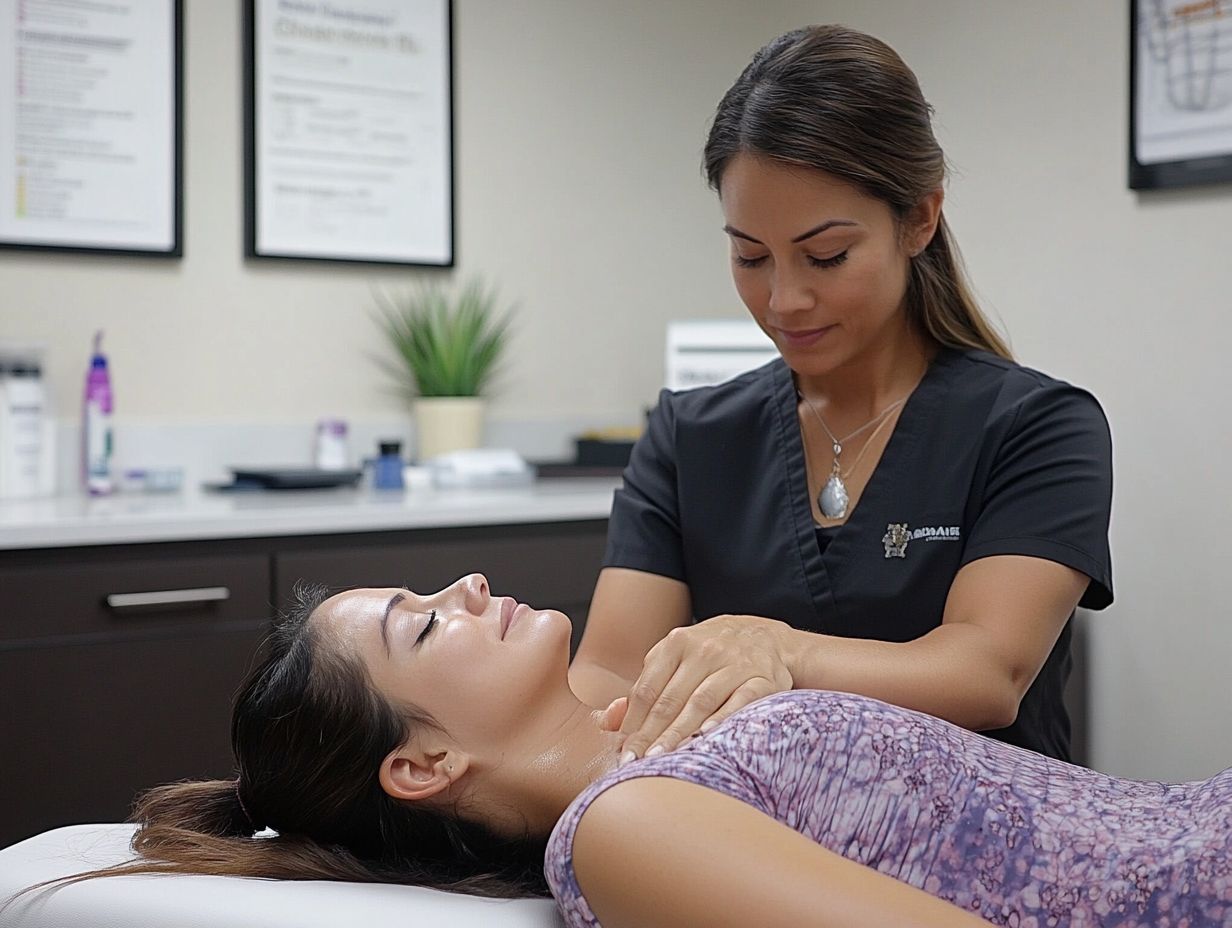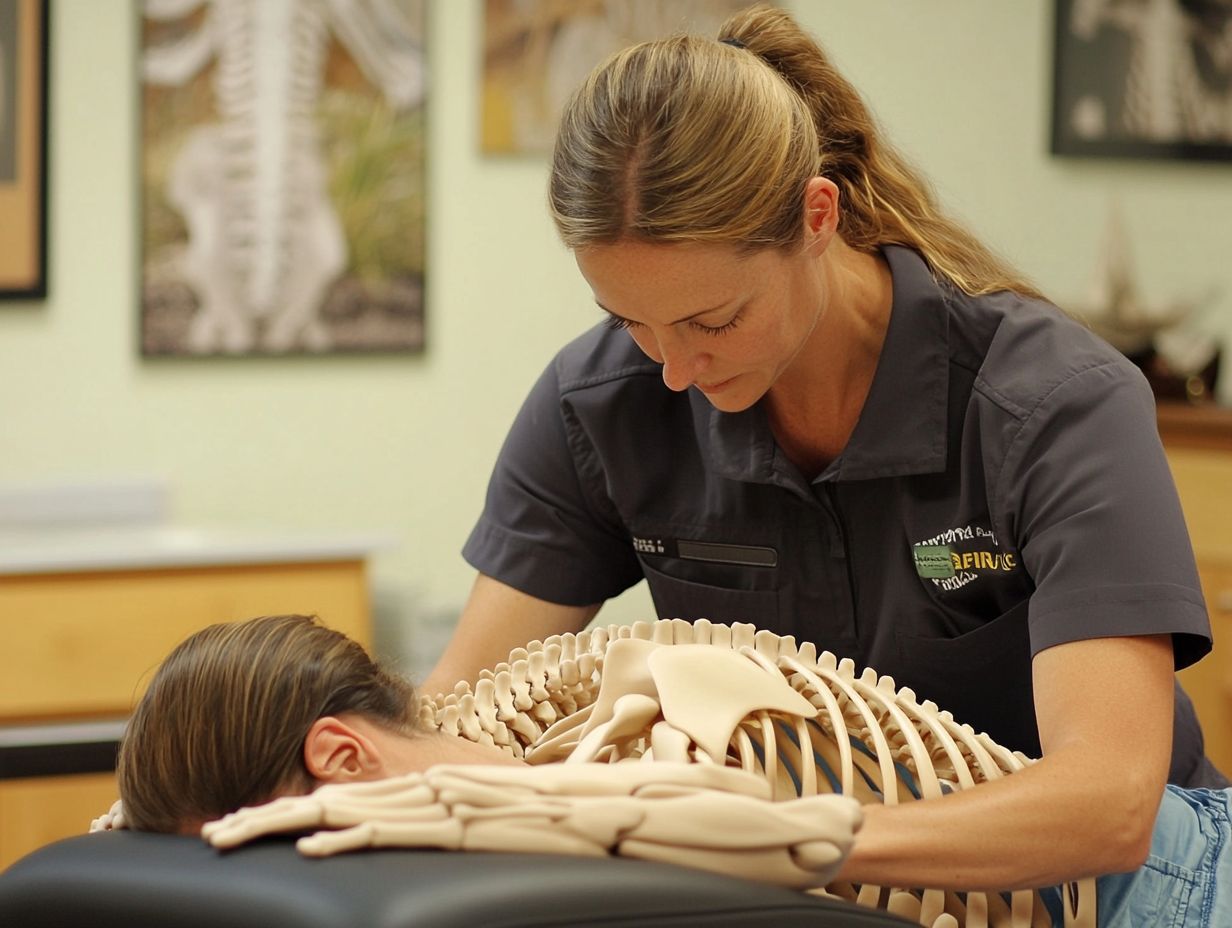Chiropractic massage represents a holistic approach that integrates the techniques of chiropractic care with therapeutic massage to promote overall wellness.
This method is effective in alleviating muscle tension, enhancing joint mobility, and addressing a variety of conditions, including back pain and sports injuries.
It is important to understand what to expect during a session and to consider tips for locating a qualified practitioner.
Explore how chiropractic massage can contribute to the enhancement of health and well-being.
What is Chiropractic Massage?

Chiropractic massage is a specialized therapeutic approach that combines chiropractic care with massage techniques to promote spinal alignment and overall wellness. This holistic treatment method focuses on addressing underlying muscular and skeletal issues while providing pain relief and enhancing joint mobility.
By employing various manual therapy techniques, such as deep tissue massage and myofascial release, chiropractic massage seeks to improve muscle recovery, reduce tension, and alleviate discomfort, promoting functional movement and overall wellness.
Patients frequently experience substantial benefits, including enhanced physical function and emotional support, thereby establishing it as a valuable option within the realm of alternative medicine.
How Does Chiropractic Massage Work?
Chiropractic massage functions by integrating chiropractic adjustments with soft tissue manipulation to alleviate muscle tension and promote healing.
The process commences with a comprehensive patient assessment to develop a personalized treatment plan that addresses the individual’s specific needs.
Techniques such as spinal manipulation, therapeutic touch, and deep tissue massage are utilized to enhance joint mobility, improve posture, and assist in pain management.
This integrative approach not only addresses physical discomfort but also supports the overall function of the nervous system, contributing to a sense of balance and well-being while enhancing neuromuscular therapy.
What Are the Benefits of Chiropractic Massage?
Chiropractic massage provides a comprehensive array of health benefits that significantly contribute to improved physical wellness and overall health.
By effectively alleviating muscle tension and stress, this holistic approach not only enhances relaxation but also facilitates pain relief for conditions such as back pain and neck pain, supporting an active lifestyle.
Additionally, patients frequently report increased joint mobility and an improved range of motion, which in turn enhances physical function and aids in injury prevention.
The therapeutic advantages of chiropractic massage extend beyond the physical realm, fostering emotional well-being and promoting a greater sense of balance.
1. Relieves Muscle Tension
One of the primary advantages of chiropractic massage lies in its capacity to alleviate muscle tension through targeted therapeutic techniques. By utilizing methods such as deep tissue massage and myofascial release, practitioners effectively address trigger points and areas of tightness, thereby promoting muscle relaxation and comprehensive tension relief.
This approach not only mitigates discomfort but also enhances mobility, enabling a greater range of motion and improved physical functionality.
Plus these methods, techniques such as trigger point therapy and stretch-based approaches are instrumental in restoring the body to its natural state. Trigger point therapy specifically targets points that cause pain, effectively breaking cycles of discomfort through precise pressure and manipulation.
Stretching methods further enhance flexibility and facilitate the body’s recovery processes.
Together, these therapies highlight the significance of chiropractic massage not merely as a remedy for pain, but as a holistic approach to fostering overall well-being and vitality. The application of these techniques aids clients in achieving long-term relief and an enhanced quality of life.
2. Improves Joint Mobility
Chiropractic massage is essential in enhancing joint mobility, as it emphasizes spinal alignment and the overall mechanics of the body. Through chiropractic adjustments and manual therapy techniques, practitioners facilitate the restoration of proper function to the joints, thereby improving their range of motion and alleviating discomfort.
Enhanced joint mobility not only fosters better physical function but also plays a significant role in injury prevention and rehabilitation, highlighting the importance of preventive care.
By incorporating various modalities such as soft tissue manipulation, myofascial release, and stretching into their practice, practitioners effectively target the tight muscles and connective tissues surrounding the joints. This holistic approach not only mitigates pain but also ensures that the spine remains properly aligned, creating an optimal environment for movement and stability.
Techniques such as Gonstead or Diversified adjustments are particularly effective in relieving pressure on nerves while aiding in the restoration of normal posture, which is fundamental for maintaining joint health and enhancing athletic performance.
The cumulative effect of these practices not only promotes recovery but also encourages long-term wellness and vitality.
3. Reduces Pain and Inflammation
Chiropractic massage is recognized for its effectiveness in reducing pain and inflammation associated with various conditions. By employing techniques such as soft tissue therapy and chiropractic adjustments, practitioners specifically target affected areas to promote healing and enhance pain management.
The therapeutic benefits of chiropractic massage extend to rehabilitation therapy, where consistent treatment can lead to significant improvements in patient outcomes and overall quality of life.
This holistic approach not only addresses immediate discomfort but also aims to prevent future issues. One notable technique is myofascial release, which alleviates tension in the connective tissue and enhances blood flow to the muscles. Additionally, trigger point therapy specifically targets knots that can cause considerable pain, thereby providing relief and facilitating a quicker recovery process.
Through these methods, chiropractic massage effectively alleviates pain and reduces inflammation, enabling individuals to regain mobility and engage in daily activities with reduced discomfort. These techniques work synergistically to promote long-term health and well-being.
4. Promotes Relaxation and Stress Relief

Chiropractic massage effectively promotes relaxation and stress relief through its calming techniques and therapeutic touch. By addressing both physical tension and emotional stress, this holistic therapy fosters a sense of well-being and balance.
Patients frequently report a reduction in stress levels and enhanced mental clarity, which positions chiropractic massage as a vital component of comprehensive wellness programs.
This therapeutic approach not only alleviates discomfort in the muscles and joints but also aids in the release of endorphins, the body’s natural pain-relievers, thereby contributing to an improved mood.
The rhythmic strokes and precise manipulation involved in chiropractic massage facilitate enhanced blood circulation, which further diminishes symptoms associated with chronic stress.
As individuals experience relief from physical ailments, they often discover a renewed sense of calm that extends beyond the treatment session, promoting emotional stability and resilience, contributing to personal wellness.
Regular engagement in this nurturing practice establishes a foundation for healthier coping mechanisms and significantly enhances overall quality of life.
What Conditions Can Chiropractic Massage Help With?
Chiropractic massage is a highly effective approach for addressing a range of conditions associated with muscular and skeletal issues, offering substantial pain relief and facilitating the healing process.
Commonly treated conditions include:
- Back pain
- Neck pain
- Headaches, a common form of chronic pain
- Sports injuries
- Arthritis
Through the application of targeted therapeutic techniques, chiropractic massage supports rehabilitation and improves overall physical function, rendering it a valuable option for individuals seeking alternative medicine solutions.
1. Back and Neck Pain
Chiropractic massage is particularly advantageous for individuals experiencing back and neck pain, as it addresses the underlying causes of discomfort. Through the application of chiropractic adjustments and soft tissue manipulation, practitioners can effectively manage pain and restore proper alignment. These therapeutic techniques not only alleviate symptoms but also contribute to the prevention of future occurrences.
By concentrating on spinal alignment and muscle relaxation, chiropractic massage creates an environment conducive to healing. Techniques such as myofascial release, deep tissue massage, and targeted stretching routines are employed to enhance mobility and reduce tension in the affected areas.
Consequently, patients often report immediate relief, along with long-term improvements in overall function. These treatments also serve to educate individuals regarding proper ergonomics and posture, thereby equipping them with strategies to prevent injury and discomfort in the future.
2. Headaches and Migraines, key areas of pain management
Chiropractic massage has been demonstrated to be effective in providing pain relief for headaches and migraines by addressing tension in the neck and upper back muscles. The therapeutic techniques employed during sessions can alleviate the stress and muscle tightness that frequently trigger these conditions, resulting in improved overall well-being.
By utilizing specific approaches such as myofascial release and trigger point therapy, practitioners can effectively target key areas that contribute to headaches, leading to significant reductions in the frequency and intensity of pain. The incorporation of spinal adjustments can enhance blood flow, nerve function, and improve spinal column health, further supporting the body’s natural healing processes.
Through consistent treatment, individuals often report not only a decrease in the frequency of migraine episodes but also an improved quality of life, enabling them to engage in daily activities with renewed energy and comfort, promoting a wellness lifestyle.
3. Arthritis
Individuals suffering from arthritis can derive significant benefits from chiropractic massage, as it aids in reducing inflammation, alleviating joint pain, and enhancing joint health. By utilizing gentle techniques focused on soft tissue manipulation and joint mobility, practitioners can improve physical function, alleviate discomfort associated with arthritis, and enhance overall mobility.
These techniques typically include myofascial release and gentle stretching, which serve to relieve tension in surrounding muscles, enhance blood circulation, and support body alignment. With regular sessions, affected joints may exhibit increased flexibility, thereby facilitating individuals’ ability to engage in daily activities without the persistent burden of pain.
Chiropractic massage also has the potential to stimulate the nervous system, promoting better communication between the body and the brain, which is essential for managing chronic conditions such as arthritis through improved body mechanics.
Notably, patient testimonials frequently emphasize improvements in quality of life, enhanced capability to perform routine tasks, and increased patient satisfaction after integrating these treatments into their wellness plans.
4. Sports Injuries
Chiropractic massage serves as a valuable resource for athletes recovering from sports injuries, facilitating rehabilitation exercises and promoting muscle recovery. Techniques such as deep tissue massage and soft tissue therapy address muscle imbalances and contribute to injury prevention, enabling athletes to return to their sport in optimal condition and improved physical fitness.
Plus these techniques, targeted stretching and joint mobilization are utilized to enhance flexibility and reduce tension. This comprehensive approach not only alleviates pain but also promotes proper alignment, biomechanics, and function of the musculoskeletal system.
By implementing a range of methods tailored to individual needs, recovery time can be significantly reduced. The integration of chiropractic massage into an athlete’s recovery regimen can lead to improved performance, as it effectively enhances circulation, diminishes inflammation, builds resilience against future injuries, and supports functional health.
With ongoing support from chiropractic care, athletes are better prepared to meet the demands of their sport.
What to Expect During a Chiropractic Massage Session?

During a chiropractic massage session, patients can anticipate a comprehensive therapeutic environment that commences with a thorough assessment to identify their individual needs and establish a personalized treatment plan.
The session generally encompasses hands-on manipulation and various therapeutic techniques specifically tailored to address the patient’s unique concerns, thereby ensuring an effective treatment experience that incorporates holistic health principles.
1. Assessment and Consultation
The initial phase of a chiropractic massage session entails a comprehensive assessment and consultation, during which the chiropractor collects pertinent information regarding the patient’s health history and specific concerns. This process is essential for determining the most effective chiropractic techniques and formulating a personalized care plan that addresses the individual needs of the patient.
By gaining a thorough understanding of the patient’s symptoms, lifestyle, and medical background, the chiropractor is better equipped to identify underlying issues that may contribute to discomfort or dysfunction. This critical evaluation not only aids in the selection of appropriate treatment methods but also enhances communication between the practitioner and the patient, fostering a collaborative approach to the healing process through effective patient education.
Consequently, the chiropractor can develop a strategic plan that incorporates a variety of modalities, ensuring that the treatment objectives align effectively with the patient’s goals, ultimately facilitating a more efficient recovery process and wellness therapy.
2. Treatment Plan
Following the assessment, a comprehensive treatment plan is formulated, detailing the specific goals and techniques to be utilized during the chiropractic massage sessions. This plan may encompass various rehabilitation therapy approaches and wellness strategies designed to optimize physical function and bodywork benefits and enhance overall well-being.
The personalization of this treatment plan is essential, as it ensures that the therapeutic modalities are tailored to the individual’s unique bodily requirements and lifestyle considerations. Elements commonly included in the plan may consist of:
- Targeted massage techniques
- Specific stretching exercises
- Strength-building activities aimed at addressing areas of tension or weakness
The treatment schedule may be modified over time to reflect the patient’s progress, thereby maintaining engagement and motivation throughout the healing process.
Additionally, educating the individual about self-care practices can significantly enhance the effectiveness of the chiropractic massage and contribute to sustained wellness.
3. Hands-on Manipulation and Massage
Hands-on manipulation and various massage techniques constitute the foundation of chiropractic massage sessions, enabling practitioners to effectively address muscle tension, improve spinal alignment, and enhance overall physical wellness.
By employing a range of therapeutic modalities, chiropractors can customize their approach to meet the individual needs of each patient, thereby ensuring optimal outcomes.
These techniques typically encompass methods such as:
- spinal adjustments
- soft tissue manipulation
- stretching
All specifically designed to alleviate pain, increase mobility, and promote healing. For example, spinal adjustments assist in restoring proper vertebral alignment, which mitigates nerve pressure and reduces discomfort. Soft tissue manipulation focuses on addressing underlying muscle issues, promoting enhanced blood flow and reducing inflammation.
Each of these hands-on techniques is crucial not only for alleviating immediate symptoms but also for facilitating long-term health improvements, ultimately enableing individuals to lead more active and fulfilling lives.
4. Home Care Recommendations
Following a chiropractic massage session, patients typically receive home care recommendations designed to enhance recovery and promote a wellness-oriented lifestyle. These recommendations may encompass stretches, exercises, and lifestyle modifications that support ongoing health and well-being, in addition to patient education aimed at enableing individuals throughout their recovery journey.
By implementing these tailored suggestions, individuals can significantly enhance their flexibility and strength, which are essential for maintaining the benefits achieved during the massage. Adopting these practices not only aids in pain alleviation but also encourages a proactive approach to preserving optimal spinal health, addressing stress management, and overall wellness.
Integrating such habits into daily routines ensures that the effects of chiropractic treatment extend beyond temporary relief, forming part of a comprehensive strategy for long-term vitality and adaptive strategies for improved health. Consequently, awareness and consistency in adhering to these home care recommendations can facilitate a more fulfilling and active lifestyle.
Is Chiropractic Massage Safe?
Chiropractic massage is widely regarded as safe for the majority of individuals when conducted by qualified chiropractic specialists. Evidence-based practices substantiate the efficacy of chiropractic treatment methods in facilitating pain relief and promoting overall well-being while minimizing associated risks related to neurology and chronic conditions.
Patient care is of utmost importance, with thorough assessments performed to confirm that each treatment aligns with the individual’s health status and supports biomechanical function. This approach not only cultivates a healing environment but also fosters trust between practitioners and patients.
Qualified chiropractic professionals possess the requisite training to identify any underlying health conditions and optimize pain reduction strategies and adapt their techniques accordingly, which is essential for achieving optimal outcomes.
Ongoing research and clinical trials contribute significantly to the body of knowledge in this field, enabling specialists to employ the most effective methods while strictly adhering to safety guidelines. By integrating patient feedback and clinical evidence, practitioners can develop personalized treatment plans that enhance recovery and support overall health, ensuring a comprehensive approach to wellness.
How to Find a Qualified Chiropractic Massage Therapist?

Finding a qualified chiropractic massage therapist is essential for ensuring effective treatment and optimal patient outcomes. Prospective patients should seek certified professionals within chiropractic clinics who are knowledgeable in kinesiology and therapeutic techniques who prioritize patient-centered care and have demonstrated expertise in various therapeutic techniques. Research studies can also provide valuable insights into therapist qualifications, treatment effectiveness, and current wellness trends.
It is crucial to seek professionals who possess the necessary certifications and licenses, as these indicators reflect their training and adherence to industry standards, crucial for effective physical therapy and patient treatment. Evaluating the reputation of the clinic is equally important; patient reviews and testimonials often provide insight into the quality of care delivered and the overall patient experience.
Inquiring about the therapist’s approach to treatment is advisable, as a commitment to individualized care, including manual manipulation techniques, can significantly enhance healing and comfort during sessions. Additionally, scheduling a consultation to discuss their methodologies is beneficial, ensuring that the selected therapist aligns with personal health goals.
Frequently Asked Questions
What is chiropractic massage?
Chiropractic massage is a form of manual therapy that combines chiropractic techniques with massage therapy. It involves manipulating the soft tissues and joints of the body to alleviate pain and improve overall health.
How is chiropractic massage different from traditional massage?
While both chiropractic massage and traditional massage involve manipulating the soft tissues of the body, chiropractic massage focuses on correcting misalignments in the spine and joints, while traditional massage focuses on relaxation and tension relief.
What are the benefits of chiropractic massage?
Chiropractic massage can help improve posture, reduce pain and inflammation, increase range of motion, and promote overall wellness. It can also help with specific conditions such as sports injuries, headaches, and back pain.
Is chiropractic massage safe for treating stiffness and pain syndromes?
Yes, chiropractic massage is generally considered safe for most people. However, it is important to consult with a licensed and experienced chiropractor to ensure that it is appropriate for your specific condition and needs.
How long does a chiropractic massage session last?
The duration of a chiropractic massage session can vary depending on the specific treatment plan and individual needs. On average, sessions can last anywhere from 30 minutes to an hour.
How many chiropractic massage sessions do I need?
The number of chiropractic massage sessions needed will depend on your specific condition and response to treatment. Typically, patients may need anywhere from 4-10 sessions for optimal results.
